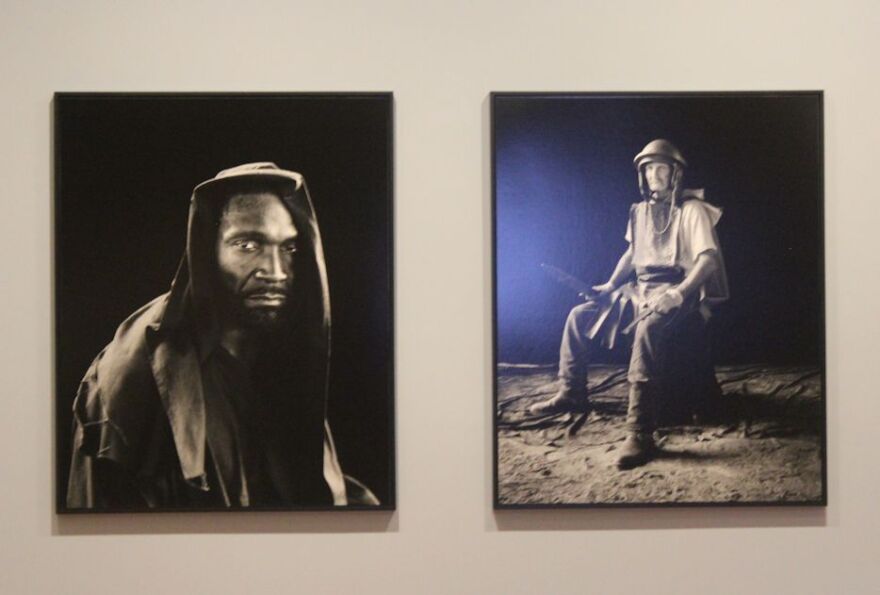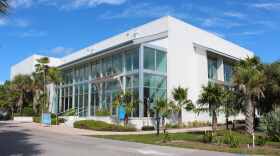Adolescence is often a time of turmoil. For the Baker Museum at Artis-Naples, adolescence has been especially turbulent, denoted by lengthy closures, first from damage suffered by the exterior of the building during Hurricane Irma in 2017, and then as a result of the COVID-19 pandemic.
Under the helm of new Gallery Director and Chief Curator Courtney McNeil, the Baker Museum has emerged from these challenges better than ever and committed to enticing visitors from new demographics and segments of Southwest Florida’s diverse population.

“This is a great time of year for locals to come out,” said NcNeil. “Traffic is easy. It’s a nice thing to do when those afternoon thunderstorms, when it’s pouring rain out. We’re here. We’re air conditioned. We’re open, and it’s just a wonderful way to spend a day or an afternoon.”
Even before they enter the museum’s grand foyer, which is dominated by a three-story Chihuly icicle consisting of 377 blown glass pieces, visitors will pass through a broad, completely re-imagined courtyard culminating in the Norris Garden and it’s cozy Heidi’s Place snack-ateria. Inside, the square footage is roughly the same as before, but renovations spurred by Hurricane Irma have rendered the space far more user friendly, said McNeil.

“The square footage that we have is pretty consistent but now we’re able to use the space in more exciting ways now that a few tweaks have been made inside.”
The Baker Museum focuses on American, Mexican and European modernism from the 20th century to the present. McNeil knows many people find museums and modernism intimidating. but you don’t have to have an art degree to enjoy the exhibitions on display.
“Many people feel they’re not qualified to enjoy or have an opinion about the visual arts, like there’s a barrier to entry there, and I think that most museum professionals and certainly people advocating for public art feel the exact opposite,” said McNeil.
“Anybody has something to gain from engaging with the visual arts, whether it’s looking at the world through a slightly different lens, gaining empathy after understanding something an artist is trying to communicate from their perspective or even if it’s just a passing moment of beauty and joy, there’s something for everybody to be gained from the visual arts.”
McNeil is also committed to creating an exciting and engaging visitor experience at the museum for Southwest Florida’s Spanish-speaking population.
“Walking in you can see we interpret all of our permanent collection shows in both English and in Spanish. So, all of the text in this exhibition is bilingual. That is part of a broader goal to reach more people in our community and to show our relevance to a broader swath of the community. Someday I would love to be able to do bilingual interpretation for everything that we do, but for now we’re doing that with the permanent collection, which I’m proud of and happy to do.”
The Baker Museum has amassed a formidable collection in the 20 years it its existence. With more than 4,000 objects in its permanent collection, it is comparable in size to the Dali Museum in St. Petersburg and larger than the Sarasota Museum of Art, but The Baker is not competing with other museums for visitors.
“I’m aware of the fact that art museums aren’t competing for peoples’ attention with other art museums. We’re competing with staying home and watching Netflix on your couch. We’re competing with a day at the beach. We’re competing with any number of other leisure activities that people could use to fill their time,” said McNeil.
“And here, I think it’s all about balance. In the summertime in Naples, sure the beach is lovely and it’s less crowded than it is in peak season, but it is fantastic to have indoor activities as well as to give a dose of culture, to give a dose of thought and reflection into your otherwise busy week.”
Now that the museum is once again open, staff plan to entice folks off the couch and through its doors with two truly fantastic exhibitions staged back to front on the museum’s third floor. The first spotlights never-before-seen works that the museum acquired while it was shut down for renovations and as a result of the COVID-19 pandemic. “The works that you see here have been acquired from 2019 to the present day. A lot of this was during the COVID era when we didn’t have a chance to put things out on view right away. So most of these items are out on view for the first time to the public, which we’re really excited about,” said McNeil.
McNeil is perhaps most excited for the public to see a collection of Louise Nevelson prints that help shed a different perspective and new light on her work and practice. Of course, Nevelson’s last legendary installation, “Dawn’s Forest,” remains on display in Hayes Hall on the Artis-Naples campus.
For fans of magical surrealism, there’s an entire room devoted to works by Mexican surrealist Enrique Chavarria.

“Enrique Chavarria is a surrealist artist from Mexico, who’s really under-exhibited and underrepresented in museum collections. We acquired these works several years ago, but they needed conservation,” said McNeil.
“So, we worked with a conservator that we contract with in Miami who spent months working on the front of the works, the backs of the works and the frames themselves needed work, but I love the influences from medieval to 20th century composition; everything from the open window and the architectural setting. The symbolism and the surrealism of these works are really engaging and unusual.”
The other exhibition is called “True Likeness.” This show invites viewers to re-examine why we are so mesmerized by our own faces and the ones we encounter as we re-emerge from our homes in the wake of the pandemic.

“Because of so many mask mandates I think all of us have had the experience of knowing somebody – a colleague or a neighbor or somebody you’ve known for many months – and then realize later oh, I haven’t seen their full face ‘till a week or so ago. So I think we’re looking at each other’s faces with different eyes now and we’re appreciating the type of information that can be communicated by the human face in whatever the artistic mode may be, whether it’s a photograph or a video or a painting,” said McNeil.
Every artist included in “True Likeness” has something important to contribute to this conversation, but two, in particular, are worth the trip to The Baker alone.
One is Endia Beal’s “Mock Interview.” Beal is African American and she created a video that depicts young white men at a job interview being asked questions actually posed by white employers to Black women between the ages of 27 and 58. The interviewees’ reactions to being asked “Would you change your name for this job?” and “Would you change your hair?” are, well, priceless.

The same is true of Deborah Luster’s photographs from her project “Passion Play” of two inmates at Louisiana’s Angola Prison who were taking part in the Angola Prison Drama Club’s production of “The Life of Jesus Christ.” You don’t just see actors in costume. Luster’s haunting images reveal the soul of the performers, who saw pieces of their own lives reflected in the characters they played.

With new direction, new digs and two exciting new exhibitions, the Baker Museum is the place to go this summer, but get there in the next four weeks because the museum closes for summer maintenance on July 25 and won’t reopen until Sept. 6.
FOR MORE INFORMATION:
‘True Likeness’ portrait show at Baker Museum through September 25, 2022
‘Recent Acquisitions: 2019-Present’ at Baker Museum through January 8, 2023
Baker Museum one of Southwest Florida’s foremost fine art museums
FAST FACTS:
- Courtney A. McNeil is an award-winning curator, art historian and museum leader with nearly two decades of museum and gallery experience. Prior to joining the Baker Museum, she served 15 years in the curatorial department of Telfair Museums in Savannah, Georgia, most recently holding the title of chief curator and deputy director for curatorial affairs. At Telfair, she was responsible for overseeing all of the museum’s programmatic activities. McNeil also held positions at Childs Gallery in Boston, Massachusetts, where she specialized in American painting and works on paper, and in the publications department of the National Gallery, London. McNeil has a proven record of championing projects that complicate traditional art historical narratives in order to provide audiences with opportunities for authentic engagement and conversation around the most vital issues of our time. She specializes in aligning the activities of the exhibitions, collections, and education teams and implementing data-driven approaches in order to fulfill strategic goals.
- The 35-foot-tall Dale Chihuly hanging sculpture in the foyer of the Baker Museum is called Blue Icicle Chandelier and is a companion piece to the Red Chandelier that hangs in Hayes Hall.
- “Recent Acquisitions” is physically connected to “True Likeness” by another Chihuly artwork, “Persian Seaform Ceiling,” which spans the length of a third-floor hallway between the two shows.
- Also included in the “Recent Acquisitions” exhibit is a three-panel painting by popular local artist Mally Khorasantchi and a work by Hunt Slonem, who is widely collected in the Naples area.
- The interview subjects in Endia Beal’s “Mock Interview” video were male students between the ages of 20 and 23. Beal chose white men because they have traditionally dominated the corporate sector, and Beal believes it is imperative that all races contribute to the conversation around diversity, equity, and inclusion. The men were informed that they would be asked discriminatory questions that were previously given to women of color during their interviews, but, as is traditionally the case when interviewing, they did not know the questions in advance. While overall, Beal created her "Mock Interview” video to bring awareness to employment discrimination for women of color and to create a greater sense of empathy, the piece illustrates the scope and breadth of the information we can glean from watching the expressions on people’s faces.
- Deborah Luster is a photographic artist from Northwest Arkansas. A professional photographer since the 1990s, she is known for using older technology such as tintype to document and artistically portray violent crime and related topics. Her images in “True Likeness” are part of a series she undertook between 2012 and 2013 at Angola Prison, where of the 5,300 inmates at the Louisiana State Prison there, nearly 4,000 are serving life sentences. In 2012 and 2013 the Angola Prison Drama Club staged a play unlike any other in the prison's experience. “The Life of Jesus Christ” featured 70 inmates, men and women acting together for the first time — in costume, with a real camel, performing for the general public.
To read more stories about the arts in Southwest Florida visit Tom Hall's website: SWFL Art in the News.
Spotlight on the Arts for WGCU is funded in part by Naomi Bloom, Jay & Toshiko Tompkins, and Julie & Phil Wade.
WGCU is your trusted source for news and information in Southwest Florida. We are a nonprofit public service, and your support is more critical than ever. Keep public media strong and donate now. Thank you.







